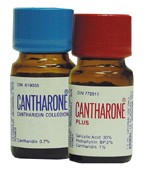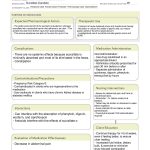
Cantharidin Topical: A Solution for Molluscum Contagiosum
Cantharidin topical is a solution for the treatment of molluscum contagiosum in adults and children 2 years and older. Molluscum contagiosum is a viral skin infection caused by the molluscum contagiosum virus (also known as poxvirus). This infection typically causes small raised lesions on the skin that resolve within a year, although it may take up to 4 years in some cases. Cantharidin is administered by qualified healthcare professionals in a clinical setting and is not meant for home use.
Cantharidin is a natural fatty toxic substance produced by blister beetles and is also produced synthetically for topical use. It has blister-producing (vesicant) properties and the ability to break down keratin, a fibrous protein in the skin, nails, and hair. The exact mechanism of cantharidin’s therapeutic effect in molluscum contagiosum is unknown.
When applied to skin lesions, cantharidin is absorbed by the fats on the keratinocyte membrane, where it activates enzymes that break down protein. This leads to degeneration and shedding of the skin cells that form plaques. A blister develops on the application site, eventually lifting off the lesion without scarring.
The uses of cantharidin topical include:
- Molluscum contagiosum
- Warts
- Callus
- Cutaneous leishmaniasis
- Herpes zoster
- Acquired perforating dermatosis
Warnings
- Cantharidin is for topical use only. Do not use orally, on mucous membranes, or in the eyes. Ingestion can be life-threatening, and ocular contact can cause severe eye damage. If accidental contact occurs, seek immediate medical attention.
- Avoid applying on healthy skin or mucous membranes. If accidental contact occurs, clean the area immediately.
- Avoid applying other skin products to the treated area for 24 hours after application. This can spread cantharidin to other areas and cause adverse effects.
- If severe blistering or pain occurs, clean the treated area with soap and water without waiting for the recommended treatment duration to be completed.
Side Effects of Cantharidin Topical
Common side effects of cantharidin topical include:
- Blisters
- Pain
- Itching
- Scab
- Redness
- Discoloration
- Dryness
- Swelling
- Erosion
- Contact dermatitis
Contact your doctor immediately if you experience any serious side effects, such as heart symptoms, severe headache, confusion, nervous system reactions, or serious eye symptoms.
Dosages of Cantharidin Topical
Topical solution:
- 0.7% (7 mg/mL)
- Each sealed glass ampule contains 0.45mL
- Break tool packaged as 2 units/carton of applicators
Adults and Pediatric:
Molluscum Contagiosum:
- Indicated for topical treatment of molluscum contagiosum in adults and pediatric patients aged 2 years or above
- Children below 2 years: Safety and efficacy not established
- Children 2 years and above: Apply topically to cover each lesion by clinician once every 3 weeks as needed; not to exceed 2 cantharidin applicators during a single session
Administration:
- Healthcare professionals should receive instruction and training prior to the preparation and administration of cantharidin topical.
- Cantharidin topical is for topical use only.
- Avoid contact with the treatment area after application and do not apply near the eyes.
- In case of accidental exposure to unintended surfaces, immediately remove the medication.
- Avoid using other topical products on the treated area for 24 hours.
- Avoid fire, flame, or smoking near the treated area during treatment.
Overdose:
Excessive topical use of cantharidin can intensify its side effects. Oral ingestion can result in kidney failure and severe damage to the gastrointestinal tract. Overdose may be treated with symptomatic and supportive care.
Drug Interactions
No studies evaluating the drug interaction potential of cantharidin have been conducted. Inform your doctor of all medications you are currently taking to avoid any possible drug interactions.
Pregnancy and Breastfeeding
- No animal reproductive studies have been conducted on cantharidin topical use during pregnancy, and no data are available on its use in pregnant women.
- Systemic absorption from topical use is low, so use during pregnancy is not expected to expose the fetus to the drug.
- There is no information on the presence of cantharidin in human or animal milk, or its effects on milk production or the breastfed infant. Systemic absorption from topical use is low and not expected to expose the breastfed infant to the drug.
- Decision to breastfeed should consider the clinical need for cantharidin topical, the benefits of breastfeeding, and the risks to the breastfed infant.
- Avoid applying cantharidin topical on the breast or any region with a risk of potential ingestion or ocular exposure to the breastfeeding infant.
Additional Information
- Cantharidin topical should be administered only by a healthcare professional trained in its preparation and application.
- Do not touch the lesions after application and report any oral contact or accidental ingestion.
- If accidental exposure occurs in the eyes, flush with water for 15 minutes and seek medical care.
- Avoid using other skin products on the treated area.
- If severe pain or blistering occurs, wash the area with soap and water and report to your doctor.
- Avoid flame, fire, smoking, or exposure to smoke until 24 hours after treatment and until the medication is washed off.
Subscribe to MedicineNet’s Skin Care & Conditions Newsletter
By clicking "Submit," you agree to the MedicineNet Terms and Conditions and Privacy Policy. You will also receive emails from MedicineNet, but you can opt out at any time.
Summary
Cantharidin topical is a solution used for the treatment of molluscum contagiosum in adults and children 2 years and older. Common side effects include blisters, pain, itching, scab, redness, discoloration, dryness, swelling, erosion, and contact dermatitis.


